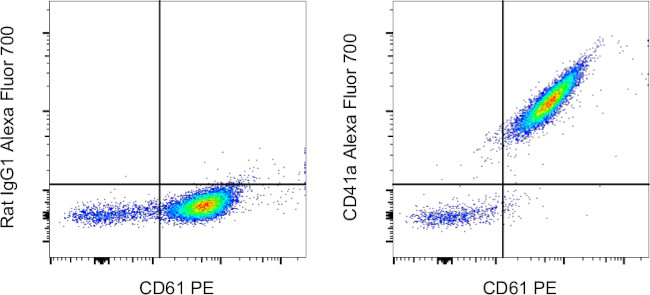Search Thermo Fisher Scientific
Invitrogen
CD41a Monoclonal Antibody (eBioMWReg30 (MWReg30)), Alexa Fluor™ 700, eBioscience™
FIGURE: 1 / 8
CD41a Antibody (56-0411-82) in Flow

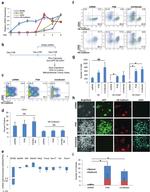

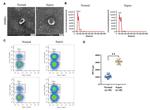
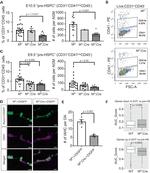

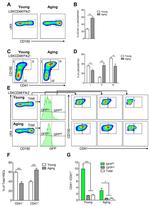
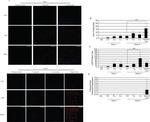
Product Details
56-0411-82
Species Reactivity
Published species
Host/Isotype
Recommended Isotype Control
Class
Type
Clone
Conjugate
Excitation/Emission Max
Form
Concentration
Purification
Storage buffer
Contains
Storage conditions
Shipping conditions
RRID
Product Specific Information
Description: The eBioMWReg30 monoclonal antibody reacts with mouse CD41 (fibrinogen receptor, gpIIb, integrin alpha IIb). While initially thought to be expressed exclusively on the surface of platelets and megakaryocytes, it has been demonstrated that CD41 is also expressed on hematopoietic progenitors in the embryo, fetus, and adult. CD41 associates with CD61 (gpIIIa, integrin beta III) to form a receptor that plays a major role in platelet function, including binding of several adhesion molecules such as fibrinogen, fibronectin, and vitronectin.
Recently, the SLAM-family markers, CD48 and CD150 have been used to reliably identify hematopoietic stem cells (HSC). Specifically, it was found that CD150+CD48- bone marrow cells were highly efficient in their ability to confer long-term multi-lineage reconstitution in irradiated mice. Furthermore, the efficiency of reconstitution was enhanced when HSCs were further enriched through the exclusion of CD41+ cells. Thus, the use of CD150+CD48-CD41- as an expression profile efficiently identifies hematopoietic stem cells.
Applications Reported: This eBioMWReg30 (MWReg30) antibody has been reported for use in flow cytometric analysis.
Applications Tested: This eBioMWReg30 (MWReg30) antibody has been tested by flow cytometric analysis of mouse platelets. This may be used at less than or equal to 0.25 µg per test. A test is defined as the amount (µg) of antibody that will stain a cell sample in a final volume of 100 µL. Cell number should be determined empirically but can range from 10^5 to 10^8 cells/test. It is recommended that the antibody be carefully titrated for optimal performance in the assay of interest.
Alexa Fluor 700 emits at 723 nm and can be excited with the red laser (633-647 nm). Most instruments will require a 685 LP mirror and 710/20 band pass filter. Please make sure that your instrument is capable of detecting this fluorochrome.
Excitation: 633-647 nm; Emission: 723 nm; Laser: Red Laser
Target Information
CD41 (platelet glycoprotein IIb, ITGA2B) is composed of two subunits -120 kDa a, alpha and 23 kDa b, beta- that interact with CD61 in the presence of calcium to form a functional adhesive protein receptor. CD41 is also involved in blood coagulation by mediating platelet aggregation. Upon blood vessel damage, CD41 binds to a variety of proteins including von Willebrand factor, fibrinogen, fibronectin and vitronectin. CD41 is mainly expressed on megakaryocyte-platelet lineage, but generally belongs to the antigens that are expressed during the early stages of hematopoietic differentiation. Diseases associated with CD41 dysfunction include Glansmann Thrombasthenia, and Platelet type-16 bleeding disorder.
For Research Use Only. Not for use in diagnostic procedures. Not for resale without express authorization.
How to use the Panel Builder
Watch the video to learn how to use the Invitrogen Flow Cytometry Panel Builder to build your next flow cytometry panel in 5 easy steps.
Bioinformatics
Protein Aliases: alpha IIb; CD41; form 1; form 2; GP IIb; GPalpha IIb; GPIIb; Integrin alpha-IIb; platelet glycoprotein IIb of IIb/II Ia complex; Platelet membrane glycoprotein IIb
Gene Aliases: AI172977; alphaIIb; CD41; CD41B; GpIIb; Itga2b
UniProt ID: (Mouse) Q9QUM0
Entrez Gene ID: (Mouse) 16399

Performance Guarantee
If an Invitrogen™ antibody doesn't perform as described on our website or datasheet,we'll replace the product at no cost to you, or provide you with a credit for a future purchase.*
Learn more
We're here to help
Get expert recommendations for common problems or connect directly with an on staff expert for technical assistance related to applications, equipment and general product use.
Contact tech support
